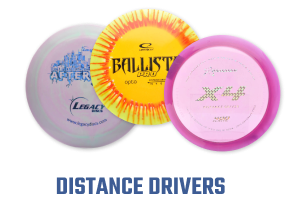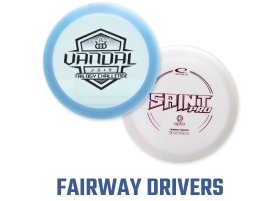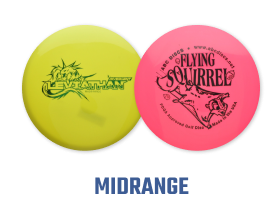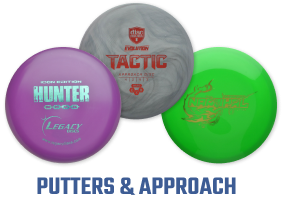
Speed is the first number in the traditional flight rating system, highlighted above on an Innova Destroyer. Speed can range in value from 1 to 15, and generally is correlated to the Rim Width of the disc:
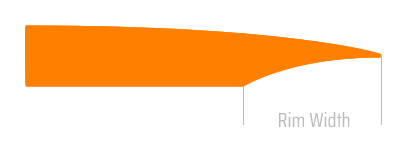
Discs with wide rims and a “sharper” profile will typically have higher Speed values, while discs with narrower rims and a more blunt profile will have lower Speed values.
What Does Speed Mean?
Technically, a disc’s Speed rating describes how aerodynamic the disc is, or how easily it cuts through the air. For the beginner, I think Speed has a more important definition.
To understand Speed you must also understand the third number in the flight rating: Turn. Turn is the tendency of the disc to turn to the right or left after you throw it.
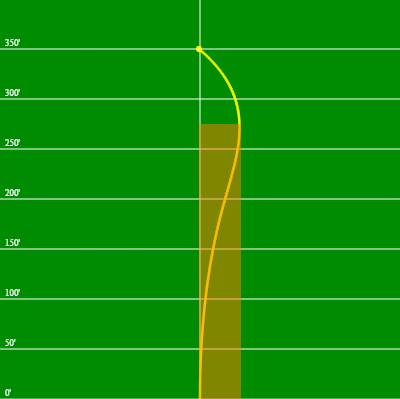
Right-handed throwers will see the disc turn to the right if they’re throwing backhand, and left-handed throwers will see the disc turn to the left when throwing backhand. Turn is the right or left motion of the disc during the early, or fastest, part of the flight. A Turn rating with a more negative number (like -4) will result in more right or left motion, while a Turn rating with a higher number (like -1 or 0) will result in straighter early flight.
Speed is the velocity or throwing power required for the disc to exhibit the full Turn rating.
If you throw a disc slower than its optimal Speed, the disc will exhibit less than its stated Turn, and if you throw it faster it will exhibit more. Below you can see the flight path for an imaginary disc with a flight rating of 8/5/-2/3 thrown at different levels of power:
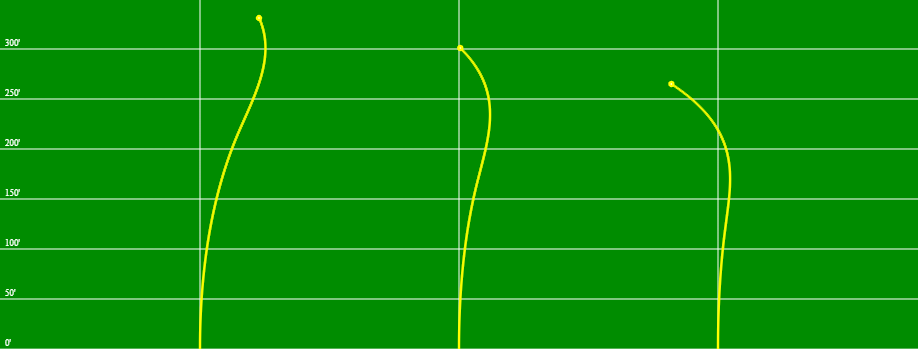
These 3 paths show what happens when you throw with more power, the right amount of power and less power than a disc requires, respectively.
The overpowered path on the left exhibits a lot more turn due to the excess velocity, and never returns back to the launch line.
The underpowered path on the right doesn’t hold the turn for very long and begins to fade much sooner in flight and finishes left of the launch line.
The center path shows the intended flight path when the power of the throw is matched to the speed of the disc.
Figuring Out Your Throwing Speed
Unfortunately, there is no standard way to equate disc Speed to velocity; we cannot say that Speed 9 is equal to 45mph, or that Speed 13 is equal to 75mph. Furthermore, it is difficult to know how fast you are actually throwing a disc without a high-speed camera or radar gun.
Rather than worrying about how fast you are throwing, I recommend that we focus on finding the fastest disc that behaves as expected when you throw at your maximum power.
To do this, I recommend that you start with a high-Speed disc and work your way down until the disc turns the way it’s supposed to. Also, use a disc with a lot of expected Turn so there will be something to see. An Innova Ape (13/5/0/4) won’t turn even when thrown hard, so how would you know if you threw it hard enough to make it turn? Instead, start with something fast that will turn like the Innova Katana (13/5/-3/3).
So you start with the Katana and it doesn’t turn at all. Assuming you made a good throw (full power, flat release, not too high in the air), this is an indicator that you’re not throwing fast enough for a Speed 13 disc. Try lower-speed discs like the Innova Beast (10/5/-2/2) or the Innova Valkyrie (9/4/-2/2) and see if those start to turn for you.
Keep repeating this process – each time lowering the Speed and selecting a disc with a noticeable amount of Turn – and eventually, you’ll start to find that the discs are traveling in a nice “S-curve” path. Once you start to see that left or right movement you’ll know that you’ve found the right Speed for your arm strength.
As you continue to practice and improve, you’ll probably find that discs are flying different, possibly turning too much and never coming back. This usually means that you’re applying more power than you used to, and that excess velocity is changing the flight path. It might be time to look for higher-speed discs that more closely match your new throwing power.
Flight Characteristics of High and Low-Speed Discs
High-speed discs tend to come back to the ground with more velocity, and may have a tendency to “skip” when they hit the ground (depending on the angle of impact).
Use a higher-speed disc when:
- You are trying to throw for maximum distance.
- Your landing zone has room for the disc to skip.
- You need the disc to hook significantly at the end of flight, to get around a row of trees for example.
Low-speed discs tend to have a softer landing and typically won’t skip nearly as much on impact.
User a lower-speed disc when:
- You need more control and less distance, such as when you are approaching the basket.
- You do not want the disc to skip much at the end of flight.
Effects of Disc Weight on Speed
Caution: math and science ahead!
The physics formula for momentum is:
p = m * v
Where p is momentum, m is mass and v is velocity. If you rearrange this formula to solve for velocity you get:
v = p / m
If you assume the force you apply to the disc thrown at maximum power stays the same, then you will produce the same momentum when throwing a lighter disc and logically the speed (velocity) of the disc will increase if you lower the mass (i.e. throw lighter discs).
As if there wasn’t already a lot to consider, adjusting the weight is another way to increase the speed of your throws. What that means is that if you’re having a hard time getting your 174g Discraft Mantis (8/4/-2/2) to turn, you might have more success if you drop down to a lighter disc in the same model.
Even though it’s difficult to measure your throwing velocity, we’ll assume one for demonstrations purposes. Say you’re throwing your 174g Mantis 40mph and producing 3.11 units of momentum (using standard SI units of kg*m/s, for those of you keeping track). The 3.11 is the important part, because that will remain constant if you change the weight of your disc and apply the same power to it.
Now let’s say you throw a 160g Mantis and apply the same level of power (3.11 kg*m/s). Your disc will now travel at approximately 43.5mph, or roughly 9% faster. That increase in velocity might just be what you need for the disc to produce the flight path that you’re expecting.
Changing the weight of your disc is a neat trick, but there are limits. When I first started playing I found and bought a 108g Innova Leopard3 (7/5/-2/1) and assumed I’d be able to blister the disc because of it’s extreme light weight:
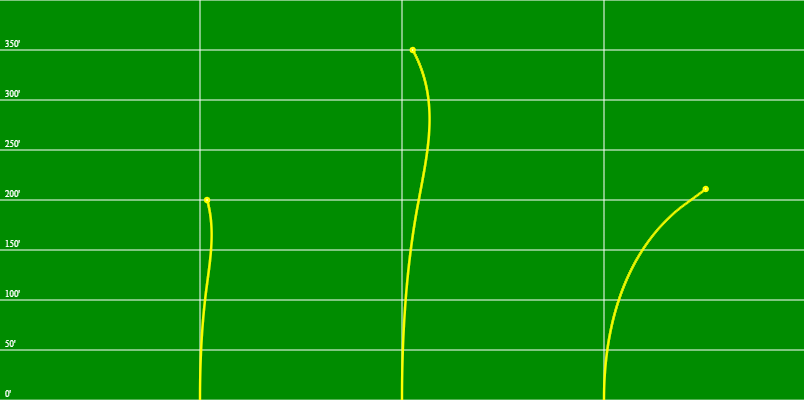
I was able to throw it much faster, but the overpowered flight caused it to turn violently and roll or smack the ground every time. And of course there are wind affects to consider, but that’s for another day.
See for Yourself
The best way to start to learn these concepts is to go out and practice. Take a stack of discs in varying weights and molds and start to find out what works for you. Throw enough times and you’ll start to see patterns – ranges of disc Speed where the disc seems to do what it’s supposed to.
I hope this article is helpful. I tried to return to when I was brand new to the sport and didn’t have any idea what the numbers on the disc meant. I’ve seen several players get frustrated and quit the sport because they couldn’t get their discs to do anything predictable. Hopefully this will help you find your groove and stick with it.

